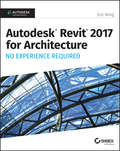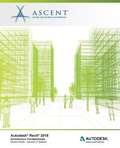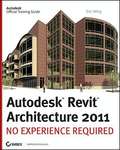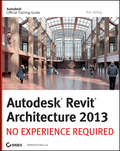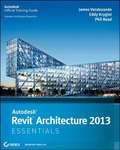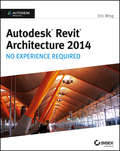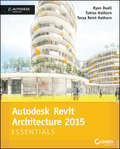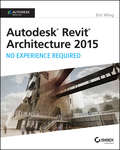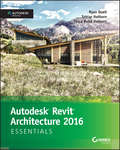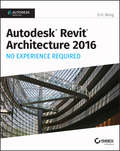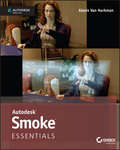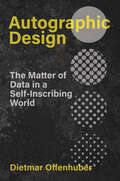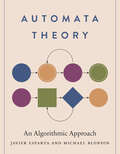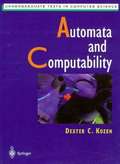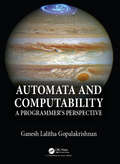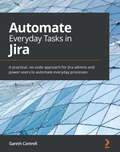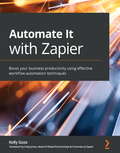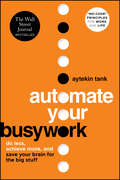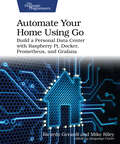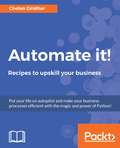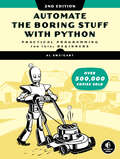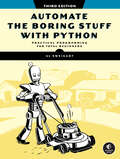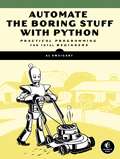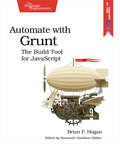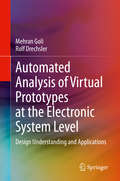- Table View
- List View
Autodesk Revit 2017 for Architecture: No Experience Required
by Eric WingThe only Revit tutorial guide based on a real project workflow Autodesk Revit Architecture No Experience Required is the ultimate real-world guide for mastering this increasingly prevalent BIM software package. Using a continuous, step-by-step tutorial, this book walks you through all project phases as you learn the basics of Revit by designing, documenting, and presenting a four-story office building. You'll begin by learning your way around the interface and conventions, then jump right into design by placing walls, doors, and windows. Next you'll work with grids, beams, foundations, dimensions, and text as you build floors layer by layer, join walls, create ceilings and roofs, and place stairs, ramps, and railings. The instruction covers construction documentation, advanced detailing, and families, as well as site considerations including grading and top surface features to provide a well-rounded, real-world Revit skill set. The companion website features downloadable 'before and after' tutorial files that allow you to jump in at any point and compare your work to the pros. The shift from 2D drafting to 3D building information modeling has made Revit a must-have skill for an increasing number of design, engineering, and construction professionals. This book is designed to teach you the basics quickly, using a real-world workflow, process, and pacing. Get acquainted with the Revit interface, then immediately start building Learn to place structural components, text, dimensions, and more Understand views, grids, editing, importing, exporting, and work sharing Generate construction documentation including schedules and material takeoffs This simple yet engaging tutorial brings together all of the major skills a Revit user needs to know to complete real workplace projects. Whether read from beginning to end as a comprehensive lesson, or used as 'dip-in' reference for unfamiliar tasks, Autodesk Revit Architecture No Experience Required provides invaluable practical BIM instruction for every phase of a project.
Autodesk Revit 2018: Architecture Fundamentals
by ASCENT - Center for Technical Knowledge<p>The Autodesk Revit software is a powerful Building Information Modeling (BIM) program that works the way architects think. The program streamlines the design process through the use of a central 3D model, where changes made in one view update across all views and on the printable sheets. <p>This student guide is designed to teach you the Autodesk Revit functionality as you would work with it throughout the design process. You begin by learning about the user interface and basic drawing, editing, and viewing tools. Then you learn design development tools including how to model walls, doors, windows, floors, ceilings, stairs and more. Finally, you learn the processes that take the model to the construction documentation phase. <p>Since building projects are extremely complex, the Autodesk Revit software is also complex. The objective of the Autodesk(R) Revit(R) 2018 Architecture: Fundamentals student guide is to enable students to create full 3D architectural project models and set them up in working drawings. This student guide focuses on basic tools that the majority of users need. <p>Topics Covered: <p> <li>Understanding the purpose of Building Information Management (BIM) and how it is applied in the Autodesk Revit software. <li>Navigating the Autodesk Revit workspace and interface. <li>Working with the basic drawing and editing tools. <li>Creating Levels and Grids as datum elements for the model. <li>Creating a 3D building model with walls, curtain walls, windows, and doors. <li>Adding floors, ceilings, and roofs to the building model. <li>Creating component-based and custom stairs. <li>Adding component features, such as furniture and equipment. <li>Setting up sheets for plotting with text, dimensions, details, tags, and schedules. <li>Creating details.</li> <p> <p>Prerequisites: <p> <li>An understanding of architectural terminology is an asset.</li>
Autodesk Revit Architecture 2011 - No Experience Required
by Eric WingLearn Revit Architecture step by step with this project-based tutorial Revit Architecture is the leading Building Information Modeling (BIM) software for architects and others in related fields. Written by renowned Revit trainer Eric Wing, this simple, yet engaging tutorial teaches you the program's basics. You'll find concise explanations, focused examples, step-by-step instructions, and an engaging hands-on tutorial project that will take you from an introduction to the interface and Revit conventions right in to modeling a four-story office building. Explains views, grids, and the program's editing capabilities, and then progresses as the building's design would in the real world Encourages you to work with structural grids, beams, and foundations and shows you how to add text and dimensions, as well as understand how to use dimensions as a design tool Walks you through building floors layer by layer and joining them to exterior and interior walls, and creating and editing roofs and ceilings as well as stairs, ramps, and railings Even with no experience, Revit Architecture and its accompanying Web site will support you as you learn Revit at your own pace.
Autodesk Revit Architecture 2012
by Eric WingThis Autodesk Official Training Guide teaches Revit to newusers The perfect introduction to Revit Architecture, Autodesk?sbuilding information modeling (BIM) software, this unique andhighly effective guide uses a continuous, step-by-step tutorial tobuild your skills. You?ll first get to know the Revit interface andbasic conventions, then quickly move right into designing,documenting, and modeling a four-story office building. Placewalls, windows, and doors; add floors ceilings, railings, andstairs; create construction documentation?and that?s just forstarters! You?ll be amazed by how rapidly you can progress.Teaches you how to use Autodesk Revit Architecture, Autodesk?sindustry-leading building information modeling (BIM) softwareUses a continuous, step-by-step tutorial that progressesthrough the book, teaching you how to design, document, and presenta four-story buildingCovers structural grids, beams, and foundations; adding textand dimensions; building floors layer by layer; joining exteriorand interior walls; creating roofs and ceilings; and much moreIntroduces embedded families and formulas, crucial siteconsiderations, and importing and exporting to various formatsIncludes a Web site with before-and-after tutorial files soreaders can compare their workBest of all, this guide is self-paced. Follow the tutorialsequentially?or jump into just the chapters you want by downloadingthe project files from the companion Web site.
Autodesk Revit Architecture 2012 Essentials
by Phil Read Eddy Krygiel James VandezandeGet the Essentials on Autodesk's fastest-growing software package!The new Essentials series from Sybex helps you quickly learn and use Autodesk software. This beautiful, task-based, full-color Autodesk Official Training Guide thoroughly covers the fundamentals of Revit Architecture, teaching readers what they need to become quickly productive with this popular building information modeling (BIM) architectural design software.By following the book's clear explanations, practical tutorials, and step-by-step exercises, you'll cover all the essentials of a typical design workflow. Topics include how to best use the interface, creating floor plans, adding walls and curtain walls, generating color fill plans, preparing documentation, as well as annotating, collaborating, and more. This four-color Essentials guide provides you with the fast and thorough grounding you need in Revit Architecture.Covers Revit Architecture 2012 fundamentals, so you become quickly productive with the softwarePrepares you for the Revit Architecture Associate and Professional certification examsUses straightforward explanations and real-world, hands-on exercises and tutorials to teach the software's core features and functionsHelps you quickly develop the skills needed throughout a project, whether you're a beginner or a more experienced user brushing up on the basicsGo from concepts to complete construction documents with this essential, full-color guide.
Autodesk Revit Architecture 2014: No Experience Required Autodesk Official Press
by Eric WingLearn Revit Architecture with an engaging, real-world continuous step-by-step tutorial This Autodesk Official Press book helps you become proficient with Autodesk's popular building information modeling software using an innovative continuous tutorial. It covers each phase of designing, documenting, and presenting a four-story office building, a real-world project you might expect to encounter on the job. Concise explanations, focused examples, step-by-step instructions, and an engaging hands-on tutorial make this Autodesk Official Press guide the perfect way to learn Revit Architecture. Expert author Eric Wing, first introduces the interface and Revit conventions and then moves directly into building modeling. You'll learn to place walls, doors, and windows, work with structural grids, beams, and foundations; add text and dimensions, and use dimensions as a design tool. As the building takes shape, you'll discover how to generate construction documentation, create schedules, consider site issues, and use Revit's rendering capabilities. Shows you how to work on a real-world design from start to finish Helps you to understand industry best practices and quickly become proficient with the user interface Explains how to effectively plan and create walls, doors, window, floors, and ceilings Details ways to create professional stairs and railings Walks you through using Revit's powerful dimensions, families, worksets, worksharing, and phase management features vEncourages you to show off your design with beautifully lit, fully rendered 3D scenes Autodesk Revit Architecture: No Experience Required features downloadable tutorial files so you can jump in at any exercise. It's the perfect resource for learning this essential BIM software.
Autodesk Revit Architecture 2015 Essentials
by Tessa Reist Hathorn Tobias Hathorn Ryan DuellYour step-by-step guide to learning Autodesk Revit ArchitectureThis detailed introduction to Revit Architecture features straightforward explanations and real-world, hands-on tutorials to teach new users the software's core features and functions.Presented in the context of real-world workflows, and using real-world projects, each chapter contains a discussion of the "why" and "how" that is reinforced with a step-by-step tutorial so you'll gain practical and applicable experience with the core features of Revit Architecture. The new pedagogical approach emphasizes learning skills to help you prepare for the Revit certification exams.Learn at your pace with step-by-step exercises, illustrated with full-color screenshots and downloadable Revit tutorial filesWork with floors, ceilings, walls, and curtain wallsUse modeling and massing to explore design ideasUse the Family Editor to create and manage familiesUnderstand effective worksharing, BIM workflows, and file managementUse rendering and visualization techniques to make your design come alivePrepare for Revit certification examsWith Autodesk Revit Architecture Essentials, you are only a step away from better, faster building design.
Autodesk Revit Architecture 2015: No Experience Required
by Eric WingLearn Revit Architecture the hands-on wayFor those who like to learn by doing, this Autodesk Official Press book shows you how to build a four-story office building one step at a time, providing you with real-world practice you might expect to encounter on the job. Concise explanations, focused examples, step-by-step instructions, and an engaging hands-on tutorial make this book the perfect way to learn Revit Architecture. In addition, you can download starting files for each chapter from the website in order to compare your work to the authors, or start fresh with any chapter in the book.Expert author Eric Wing first introduces the interface and Revit conventions, and then moves directly into building modeling. You'll learn to place walls, doors, and windows, work with structural grids, beams, and foundations; add text and dimensions, and use dimensions as a design tool. As the building takes shape, you'll discover how to generate construction documentation, create schedules, work with families, consider site issues, and use Revit's rendering capabilities. Here are some of the skills you can acquire from this book:Understanding Revit's interface, views, and gridsCreating and editing roofs, railings, stairs, and ceilingsGenerating documentation and construction schedulesUsing advanced features like creating hosted families, system families, and formulasAutodesk Revit Architecture: No Experience Required is a completely self-paced guide. You can work along with the tutorial from cover to cover or jump in anywhere. No matter how you use this book, you'll be able to transfer the useful concepts to your professional practice.
Autodesk Revit Architecture 2016 Essentials: Autodesk Official Press
by Tobias Hathorn Ryan Duell Tessa Reist HathornPut Autodesk Revit Architecture 2016 to work for you with this real-world focused guide Autodesk Revit Architecture 2016 Essentials helps you get acquainted and quickly become productive with the leading Building Information Modeling software. With a real-world focus and a tutorial-based approach, this invaluable guide features concise, straightforward explanations and hands-on exercises that walk you through the entire design process. Each chapter opens with a quick discussion of concepts and learning goals, and then briskly moves into step-by-step instruction illustrated by compelling full-color screen shots. This new edition includes expanded information on rendering and visualization, and a new discussion surrounding effective work sharing, details and annotations, drawing sets, and professional workflows. The companion website features additional tutorials, plus downloadable data sets that allow you to jump in at any point and compare your work to the pros. Revit Architecture 2016 is a powerful, sophisticated BIM application designed to boost productivity with automated documentation for every design and update. This guide takes you through the entire design process, and shows you how to get the most out of Revit every step of the way. Design walls, floors, roofs, ceilings, stairs, ramps, railings, and more Work with families, groups, and phasing, and add color fills and rendering Create compelling drawing sets with details and annotations Learn the tips and tricks experts use to get the most out of Revit Autodesk Revit Architecture 2016 Essentials gets you up to speed quickly, so you can win more bids and expedite the project approval process.
Autodesk Revit Architecture 2016 No Experience Required: Autodesk Official Press
by Eric WingGo from beginner to guru quickly with the ultimate Revit Architecture 2016 guide Autodesk Revit Architecture 2016 No Experience Required is your ultimate hands-on guide for mastering this essential BIM software. With step-by-step instruction and a continuous tutorial approach, this invaluable guide walks you through the design of a four-story office building. You'll be led through the entire design, documentation, and presentation process with expert instruction and helpful tips, so you can quickly become confident and productive. You'll follow a real-world workflow as you jump right into modeling, first placing doors and windows, then building floors layer-by-layer, adding roofs and ceilings, stairs, ramps, and railings. Coverage includes crucial information on detailing, view and match line information, and printing, plus advanced topics like curtain walls, sweeps, embedded families, and formulas. You'll delve into site considerations including grading and topsurface features, and integrate them into your design at the rendering stage. The companion website provides downloadable tutorial files so you can jump in at any point and compare your work to the pros. Revit is the industry-leading Building Information Management software, hailed for its power and sophistication. This guide helps you get the most out of the software, with expert instruction and plenty of practice. Master the interface, tools, views, and editing capabilities Work with structural objects, text, dimensions, and multi-story buildings Generate construction documentation, schedules, and material takeoffs Explore phase management, work sharing, and working with various formats BIM is the emerging paradigm for architects and others in the construction and engineering fields. Revit is the industry leader, and is quickly becoming a mandatory skillset. Autodesk Revit Architecture 2016 No Experience Required provides everything you need to get up to speed and down to work.
Autodesk Smoke Essentials
by Alexis Van HurkmanGet productive fast with this compelling, unique guide to Autodesk SmokeIf you're new to Autodesk Smoke for Mac, this guide will get you up to speed on the key tools in a practical, hands-on way. Featuring approachable, task-based exercises taken from the real world, this full-color, step-by-step book walks you through a professional workflow with the editing, compositing and finishing tool.This Autodesk Official Press title covers everything you need to know for a solid foundation in the software, including:The ins and outs of the Smoke interface, including all key toolsAudio, music, and sound effectsEditing and trimming clips for a polished editMedia management and advanced compositingWith professional-quality video footage used for all of the book's projects, this vibrant full-color guide is engaging as well as instructive. For those new to Autodesk Smoke, as well as professionals, instructors, and trainers, Autodesk Smoke Essentials is the resource you need to get productive, fast.
Autographic Design: The Matter of Data in a Self-Inscribing World (metaLAB Projects)
by Dietmar OffenhuberAn ambitious vision for design based on the premise that data is material, not abstract.Data analysis and visualization are crucial tools in today's society, and digital representations have steadily become the default. Yet, more and more often, we find that citizen scientists, environmental activists, and forensic amateurs are using analog methods to present evidence of pollution, climate change, and the spread of disinformation. In this illuminating book, Dietmar Offenhuber presents a model for these practices, a model to make data generation accountable: autographic design.Autographic refers to the notion that every event inscribes itself in countless ways. Think of a sundial, for example—a perfectly autographic device that displays information on itself. Inspired by such post-digital practices of visualization and evidence construction, Offenhuber describes an approach to visualization based on the premise that data is a material entity rather than an abstract representation. Emerson wrote, &“Every act of the man inscribes itself in the memories of his fellows, and in his own manners and face.&” In Autographic Design, Offenhuber introduces a model for design that emphasizes traces, imprints, and self-inscriptions, turning them into sensory displays.In an age where misinformation is harder and harder to identify, Autographic Design makes an urgent and persuasive case for a different approach that calls attention to the production of data and its connection to the material world.
Automata Theory: An Algorithmic Approach
by Javier Esparza Michael BlondinA comprehensive introduction to automata theory that uses the novel approach of viewing automata as data structures.This textbook presents automata theory from a fresh viewpoint inspired by its main modern application, program verification, where automata are viewed as data structures for the algorithmic manipulation of sets and relations. This novel &“automata as data structures&” paradigm makes holistic connections between automata theory and other areas of computer science not covered in traditional texts, linking the study of algorithms and data structures with that of the theory of formal languages and computability. Esparza and Blondin provide incisive overviews of core concepts along with illustrated examples and exercises that facilitate quick comprehension of rigorous material. Uses novel &“automata as data structures&” approachAlgorithm approach ideal for programmers looking to broaden their skill set and researchers in automata theory and formal verificationThe first introduction to automata on infinite words that does not assume prior knowledge of finite automata Suitable for both undergraduate and graduate studentsThorough, engaging presentation of concepts balances description, examples, and theoretical results Extensive illustrations, exercises, and solutions deepen comprehension
Automata and Computability
by Dexter C. KozenThis textbook provides undergraduate students with an introduction to the basic theoretical models of computability. Students who have already some experience with elementary discrete mathematics will find this a well-paced first course. Plenty of exercises are provided, ranging from the easy to the challenging.
Automata and Computability: A Programmer's Perspective
by Ganesh GopalakrishnanAutomata and Computability is a class-tested textbook which provides a comprehensive and accessible introduction to the theory of automata and computation. The author uses illustrations, engaging examples, and historical remarks to make the material interesting and relevant for students. It incorporates modern/handy ideas, such as derivative-based parsing and a Lambda reducer showing the universality of Lambda calculus. The book also shows how to sculpt automata by making the regular language conversion pipeline available through a simple command interface. A Jupyter notebook will accompany the book to feature code, YouTube videos, and other supplements to assist instructors and studentsFeatures Uses illustrations, engaging examples, and historical remarks to make the material accessible Incorporates modern/handy ideas, such as derivative-based parsing and a Lambda reducer showing the universality of Lambda calculus Shows how to "sculpt" automata by making the regular language conversion pipeline available through simple command interface Uses a mini functional programming (FP) notation consisting of lambdas, maps, filters, and set comprehension (supported in Python) to convey math through PL constructs that are succinct and resemble math Provides all concepts are encoded in a compact Functional Programming code that will tesselate with Latex markup and Jupyter widgets in a document that will accompany the books. Students can run code effortlessly href="https://github.com/ganeshutah/Jove.git/"here.
Automate Everyday Tasks in Jira: A practical, no-code approach for Jira admins and power users to automate everyday processes
by Gareth CantrellLearn how to automate tasks and create rules in Jira with the help of different use casesKey FeaturesAutomate daily repetitive and tedious tasks without coding experienceDiscover how to automate processes in the Jira family including Jira software, Jira Service Desk, and Jira CoreExplore different use cases to understand automation features in JiraBook DescriptionAtlassian Jira makes it easier to track the progress of your projects, but it can lead to repetitive and time-consuming tasks for teams. No-code automation will enable you to increase productivity by automating these tasks. Automate Everyday Tasks in Jira provides a hands-on approach to implementation and associated methodologies that will have you up and running and productive in no time. You will start by learning how automation in Jira works, along with discovering best practices for writing automation rules. Then you'll be introduced to the building blocks of automation, including triggers, conditions, and actions, before moving on to advanced rule-related techniques. After you've become familiar with the techniques, you'll find out how to integrate with external tools, such as GitHub, Slack, and Microsoft Teams, all without writing a single line of code. Toward the end, you'll also be able to employ advanced rules to create custom notifications and integrate with external systems. By the end of this Jira book, you'll have gained a thorough understanding of automation rules and learned how to use them to automate everyday tasks in Jira without using any code.What you will learnUnderstand the basic concepts of automation such as triggers, conditions, and actionsFind out how to use if–then scenarios and conditions to automate your processes with practical examplesUse smart values to achieve complex and more powerful automationImplement use cases in a practical way, including automation with Slack, Microsoft Teams, GitHub, and BitbucketDiscover best practices for writing and maintaining automation rulesExplore techniques for debugging rules and solving common issuesWho this book is forThis book is for Jira administrators and project managers who want to learn about automation capabilities provided in Jira. Familiarity with Jira and working knowledge of workflows and project configurations is required.
Automate It with Zapier: Boost your business productivity using effective workflow automation techniques
by Kelly Goss Cody JonesBuild easy and accessible solutions for automating mundane processes in marketing, sales, operations, and finance to enable teams to focus on core tasksKey FeaturesLearn Zapier and find solutions to specific problems with this comprehensive yet concise guideExplore various scenarios describing specific business problems and how they can be solved with ZapierDiscover expert tips and practical examples to harness the full potential of ZapierBook DescriptionZapier is an emerging no-code workflow automation technology that enables organizations to connect their cloud-based and web applications and automate data transfer between them. Zapier's built-in features and flexibility allow users to integrate thousands of business applications and create simple to complex automation to reduce time spent on repetitive tasks, thereby increasing productivity. This book is a must-have for business owners, their employees, and independent freelancers and contractors looking to use Zapier for business process automation. The book takes a hands-on approach to implementation and associated problem-solving methodologies that will have you up-and-running and productive in no time while leveling up your automation skills. You'll discover how to plan your automation building for optimal results, what are the native features available in Zapier, and the applications that connect with it, as well as how to optimally configure your workflows to automate your processes in as few steps as possible. Finally, you'll find out how to create advanced workflow automation from scratch and learn how to troubleshoot issues. By the end of this Zapier book, you'll be able to build your own advanced workflow automation using Zapier, addressing the key pain points encountered in businesses with manual and repetitive tasks.What you will learnThink creatively to plan your business workflows to overcome specific business problemsGet to grips with the native features and built-in applications available in ZapierExplore different types of third-party business applications that integrate with ZapierConfigure your workflows optimally to automate business processes and minimize task usageUse Zapier's library of pre-built workflows and create advanced workflows from scratchDiscover the extensive functionality and practical uses of Zapier's built-in appsWho this book is forThis book is for solutions architects, process consultants, business analysts, virtual assistants, digital marketers, CRM consultants, online business managers, technical consultants, bookkeepers, and accountants who want to deploy effective automation techniques in Zapier. This book will help micro, small, or medium-sized businesses to increase their productivity using workflow automation with Zapier, as well as freelancers and contractors providing digital process improvement, systemizing, and automation services. No prior experience with business process automation or Zapier is required.
Automate Your Busywork: Do Less, Achieve More, and Save Your Brain for the Big Stuff
by Aytekin TankLearn to automate your busywork and focus on what really matters In Automate Your Busywork: Do Less, Achieve More, and Save Your Brain for the Big Stuff entrepreneur, founder, and CEO of Jotform Aytekin Tank delivers a can’t-miss blueprint to help you make the most of your most precious asset: time. You’ll explore what’s possible when you offload repetitive tasks, why automation has democratized innovation, and how you can use cheap—or even completely free—no-code automation tools to transform your ability to focus on what truly matters in your business and life. In the book, you’ll discover: Why the future of business is no-code, and how you can use an automation-first mindset to unlock your productivity potential How to move from busywork to less work, and finally to having the time you need to accomplish your most important work How you can use delegation and automation to achieve “timefulness,” the state of having enough time A must-read handbook for every entrepreneur, founder, business owner, and freelancer who just doesn’t have enough hours in the day, Automate Your Busywork will also earn a place in the libraries of managers, executives, and other business leaders looking to maximize their most valuable resource.
Automate Your Home Using Go
by Mike Riley Ricardo GerardiTake control of your home and your data with the power of the Go programming language. Build extraordinary and robust home automation solutions that rival much more expensive, closed commercial alternatives, using the same tools found in high-end enterprise computing environments. Best-selling Pragmatic Bookshelf authors Ricardo Gerardi and Mike Riley show how you can use inexpensive Raspberry Pi hardware and excellent, open source Go-based software tools like Prometheus and Grafana to create your own personal data center. Using the step-by-step examples in the book, build useful home automation projects that you can use as a blueprint for your own custom projects. With just a Raspberry Pi and the Go programming language, build your own personal data center that coordinates and manages your home automation, leveraging the same high-powered software used by large enterprises. The projects in this book are easy to assemble, no soldering or electrical engineering expertise required. Build a temperature monitor that can send alerts any time defined thresholds are exceeded and report the temperature readings on a time-based series chart. Change the color of lights to visually indicate the current outdoor weather status. Create a networked motion detector that triggers an alert any time motion is detected, such as a door opening or closing, a pet wandering around, or deliveries or visitors arriving on your front porch. Even have these triggers initiate a more complex Go-based automation sequence. Integrate a small, high-resolution camera into a bird feeder that takes excellent, up-close photos whenever a bird perches at the feeder, and broadcasts them to your Discord server where your family and friends can see these wildlife captures in real time. Control your home with hardware you configure, and manage it with Go code that you create and modify any time you want to enhance your home automation capabilities. What You Need: Readers should be familiar with the Go programming language and have working knowledge of Linux. Free, open source Go-based libraries and utilities are available for download from the Internet. Readers will also need a working Raspberry Pi 3+ or higher, and a Pi Pico W microcontroller. Several other inexpensive electronic parts (touch sensors, motion detectors) are also needed for some of the projects. A Philips Hue base lighting system is also needed for the weather monitor project.
Automate it! - Recipes to upskill your business
by Chetan GiridharPut your life on autopilot and make your business processes efficient with the magic and power of Python! About This Book • Learn how to construct Python scripts to scrape data, manipulate files, and access websites' APIs • Get to know about the different types of bots, look at how to develop a simple chat bot and how bots can be used to automate business processes • This book is written in Python 3.5 syntax to future-proof your automation and you'll get an understanding of how to customize the scripts to meet your future automation needs Who This Book Is For Our audience is programmers who know Python but need not be experts. They will however know a lot of the basics of the syntax and some basic experience with the command line. Ultimately, they're people who see themselves as busy and want to find cool hacks to automate all the mundane and time-consuming tasks they find themselves doing on a daily basis. What You Will Learn • Implement file deduplication and how to parse HTML content in Python. • Study an example application that will enable you to work with spreadsheets • Get acquainted with the Python modules used to work with e-mails • Manipulate images using Pillow and schedule tasks with respect to time zones • Use XML or JSON as a message format across distributed systems • Develop a Python application with logging and see an example of debugging • Integrate Python with Mongo and Redis databases • Generate reports using Pandas In Detail This book gives you a great selection of recipes to automate your business processes with Python, and provides a platform for you to understand how Python is useful to make time consuming and repetitive business tasks more efficient. Python is a mature high level language, has object-oriented programming features, powers various apps, has a huge set of modules, and great community support. Python is extremely easy to use, can help you get complex tasks done efficiently and is an apt choice for our needs. With a classic problem-solution based approach and real-world examples, you will delve into things that automate your business processes. You will begin by learning about the Python modules to work with Web, Worksheets, Presentations and PDFs. You'll leverage Python recipes to automate processes in HR, Finance and making them efficient and reliable. For instance, company payroll — an integral process in HR will be automated with Python recipes. A few chapters of this book will also help you gain knowledge on working with bots and computer vision. You will learn how to build bots for automating business use cases by integrating artificial intelligence. You'll also understand how Python is helpful in face detection and building a scanner of your own. You will see how to effectively and easily use Python code to manage SMS and voice notifications, opening a world of possibilities using cloud telephony to solve your business needs. Moving forward, you will learn to work with APIs, Webhooks and Emails to automate Marketing and Customer Support processes. Finally, using the various Python libraries, this book will arm you with knowledge to customize data solutions and generate reports to meet your business needs. This book will help you up-skill and make your business processes efficient with the various Python recipes covered in this book. Style and approach Recipes to automate your life with Python will open your eyes to new ways to automate nearly anything you can achieve with a mouse and keyboard.In it, you'll learn how to construct Python scripts to scrape data, super-charge Excel, manipulate files, access websites APIs and much more. Our recipe-based approach will ensure that you know the purpose of a code block, and the steps you need to take to achieve that are presented in an easily digestible manner.
Automate the Boring Stuff with Python, 2nd Edition: Practical Programming for Total Beginners
by Al SweigartLearn how to code while you write programs that effortlessly perform useful feats of automation!The second edition of this international fan favorite includes a brand-new chapter on input validation, Gmail and Google Sheets automations, tips for updating CSV files, and more.If you've ever spent hours renaming files or updating spreadsheet cells, you know how tedious tasks like these can be. But what if you could have your computer do them for you? Automate the Boring Stuff with Python, 2nd Edition teaches even the technically uninclined how to write programs that do in minutes what would take hours to do by hand—no prior coding experience required!This new, fully revised edition of Al Sweigart&’s bestselling Pythonic classic, Automate the Boring Stuff with Python, covers all the basics of Python 3 while exploring its rich library of modules for performing specific tasks, like scraping data off the Web, filling out forms, renaming files, organizing folders, sending email responses, and merging, splitting, or encrypting PDFs. There&’s also a brand-new chapter on input validation, tutorials on automating Gmail and Google Sheets, tips on automatically updating CSV files, and other recent feats of automations that improve your efficiency.Detailed, step-by-step instructions walk you through each program, allowing you to create useful tools as you build out your programming skills, and updated practice projects at the end of each chapter challenge you to improve those programs and use your newfound skills to automate similar tasks. Boring tasks no longer have to take to get through—and neither does learning Python!
Automate the Boring Stuff with Python, 3rd Edition
by Al SweigartThe bestselling introduction to Python programming, revised to include the latest Python features, improved explanations, and new chapters about databases and sound files.If you&’ve ever spent hours renaming files or updating hundreds of spreadsheet cells, you know how tedious tasks like these can be. But what if you could have your computer do this work for you?In this fully revised third edition of Automate the Boring Stuff with Python, you&’ll learn how to use Python to write programs that do in minutes what would take you hours to do by hand—no prior programming experience required. Early chapters will teach you the fundamentals of Python through clear explanations and engaging examples. You&’ll write your first Python program; work with strings, lists, dictionaries, and other data structures; then use regular expressions to find and manipulate text patterns. Once you&’ve mastered the basics, you&’ll tackle projects that teach you to use Python to automate tasks like: Searching the web, downloading content, and filling out formsFinding, extracting, and manipulating text and data in files and spreadsheetsCopying, moving, renaming, or compressing saved files on your computerSplitting, merging, and extracting text from PDFs and Word documentsInteracting with applications through custom mouse and keyboard macrosManaging your inbox, unsubscribing from lists, and sending email or text notificationsNew to this edition: All code and examples have been thoroughly updated. You&’ll also find four new chapters on database integration, speech recognition, and audio and video editing, as well as 16 new programming projects and expanded coverage of developer techniques like creating command line programs.Don&’t spend your time on work a well-trained monkey could do. Even if you&’ve never written a line of code, you can pass off that grunt work to your computer. Learn how in Automate the Boring Stuff with Python.
Automate the Boring Stuff with Python: Practical Programming for Total Beginners
by Al SweigartIf you’ve ever spent hours renaming files or updating hundreds of spreadsheet cells, you know how tedious tasks like these can be. But what if you could have your computer do them for you?In Automate the Boring Stuff with Python, you’ll learn how to use Python to write programs that do in minutes what would take you hours to do by hand—no prior programming experience required. Once you’ve mastered the basics of programming, you’ll create Python programs that effortlessly perform useful and impressive feats of automation to:–Search for text in a file or across multiple files–Create, update, move, and rename files and folders–Search the Web and download online content–Update and format data in Excel spreadsheets of any size–Split, merge, watermark, and encrypt PDFs–Send reminder emails and text notifications–Fill out online formsStep-by-step instructions walk you through each program, and practice projects at the end of each chapter challenge you to improve those programs and use your newfound skills to automate similar tasks.Don’t spend your time doing work a well-trained monkey could do. Even if you’ve never written a line of code, you can make your computer do the grunt work. Learn how in Automate the Boring Stuff with Python.Note: The programs in this book are written to run on Python 3.
Automate with Grunt: The Build Tool for JavaScript
by Brian P. HoganGrunt is everywhere. JavaScript projects from jQuery to Twitter Bootstrap use Grunt to convert code, run tests, and produce distributions for production. It's a build tool in the spirit of Make and Rake, but written with modern apps in mind. This book gets you up to speed with Grunt using practical hands-on examples, so you can wrangle your projects with ease. You'll learn how to create and maintain tasks and project builds, and automate your workflow with plugins and custom tasks.JavaScript has moved from being the language you love to hate to the language you need to use. And as JavaScript applications get more complex, you need a process to manage that complexity. While online tutorials just explain how to slap together a configuration file, this book goes further and shows you how to create your own tasks, design your own project templates, combine plugins together to bring a web app to life, and build your own plugins. You'll start by learning the basics of task creation, error handling, and logging as you create a simple configuration that executes basic JavaScript code using Node.js. Then you'll jump right into file manipulation as you read, write, copy, and delete files. You'll learn how Grunt's powerful multitasks work as you build a task to concatenate files together. Once you've got a grasp on these basics, you'll build a simple app with AngularJS and CoffeeScript, using Grunt to do all the heavy lifting and script processing. Finally, you'll create your own plugin so you can understand how plugins work.Each chapter contains hands-on exercises and ideas for further study. Whether you rock Ruby or sling C#, Grunt will be a useful addition to your toolbox.What You Need:This book covers Grunt 0.4.1 and higher, and requires basic knowledge of JavaScript and command-line tools on Windows, OS X, or Linux.
Automated Analysis of Virtual Prototypes at the Electronic System Level: Design Understanding and Applications
by Rolf Drechsler Mehran GoliThis book describes a set of SystemC‐based virtual prototype analysis methodologies, including design understanding, verification, security validation, and design space exploration. Readers will gain an overview of the latest research results in the field of Electronic Design Automation (EDA) at the Electronic System Level (ESL). The methodologies discussed enable readers to tackle easily key tasks and applications in the design process.
